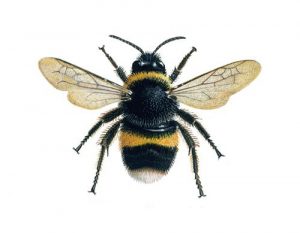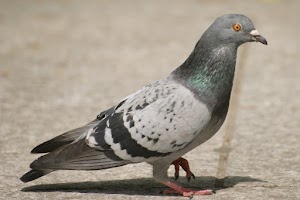Honey Bee
There are just one species of honey bee in the UK, identified by its slim, sandy thorax and black abdomen with golden-amber bands. Honeybees have been domesticated for centuries and it is rare to find a truly wild colony. Our honeybees now mostly live in hives of up to 20,000 individuals and are commonly found feeding on open flowers they can easily reach with their short tongues. Keep your eyes peeled around willows, orchard trees, oil-seed rape, raspberry flowers and other trees, herbs, and shrubs.
 Honey bees make honey from pollen and nectar collected from flowers. They live in large colonies with one queen, who can live to 3 years old, and many of her daughters as sterile females workers, and some male drones. In the wild honey bees nest in hollow trees.
Honey bees make honey from pollen and nectar collected from flowers. They live in large colonies with one queen, who can live to 3 years old, and many of her daughters as sterile females workers, and some male drones. In the wild honey bees nest in hollow trees.
When a new queen emerges, she embarks on a mating flight. On returning to her hive, with help from the workers, she kills the failing, old queen. Alternatively, before the new queen emerges, the old queen may leave with a swarm of workers to form a new colony.
How to tell if You have Honey Bee.
- Honey bee’s all-brown colouring and no whitetail. They range from ginger to a pale, sandy brown, depending on how sun-bleached they are.
- Common carder bees are very common and are found everywhere from arable land to urban gardens. Gorse is a favourite food plant alongside things like dandelions, dead-nettles, comfrey, selfheal and foxgloves.
Upon finding a honey bee nest, please Contact Us and leave everything as it is.
Please do not try and removing/killing them, We are professionals and work alongside professional beekeepers that will try our best in removing honeybees without the use of and insecticides
They are most visible in summer and late spring when new queens leave their old colonies along with thousands of workers to build new nests. At this time, large groups of bees can be seen swarming together to find a new nesting place. It takes a swarm approximately 24 hours to locate a new nesting site.
How to identify if its a bumble bee or honey bee.
 Bumblebee Bumblebee |  Honeybee Honeybee |
|
|
|
|
|
|
|
|
|
|
|
|
|
|
|
|
|
|
|
|
|
|
TESTIMONIALS
Please see some recent feedback.
Book Your Free Pest Evaluation Today
Book your free, no obligation site inspection today and one of our technicians will contact you to arrange a visit to your property at a time and date that suits you. Same day service available at no additional cost. Please complete and submit the form below or call us on 0800 002 9062 and one of our agents will assist you further.
Call us today for a free, no obligation quotation on 0800 002 9062
or email us to: info@avantipestsolutions.co.uk







